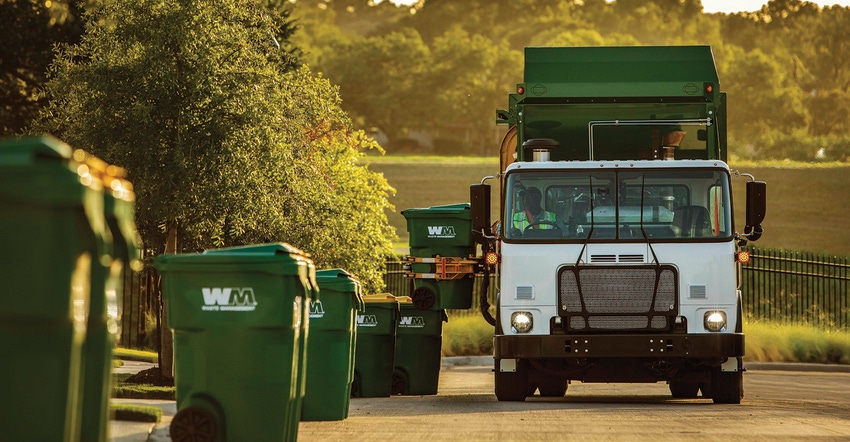Labor Shortage Drives Automation for Waste Management in Q3

The waste industry continues to gain momentum as 2021 enters its fourth quarter.
Waste Management presented its Q3 earnings, showing that despite inflationary costs and labor shortages, robust volumes and a demand for recycled content is driving company growth.
"Our third quarter performance highlighted the exceptional cash generation capability of our business model as we generated nearly $1.2 billion of cash from operations," said Jim Fish, WM president and CEO. "Our solid results put us on track to meet the higher full-year financial outlook we provided last quarter, even as we face some of the highest inflation that we've seen in years, along with the labor and supply chain constraints."
Inflationary challenges continue to impact the company, with about $60 million of labor inflation and $100 million of inflation in other operating cost categories. In Q3, underlying labor inflation was 8.7 percent.
Disciplinary price programs were the primary method of combatting cost inflation. Adjustments to pricing programs led to a core price of 4.6 percent, up from 3.2 percent in Q3 2020 and collection and disposal yield of 3.5 percent, which was up from 2.6 percent in Q3 2020. WM's residential line of business met a yield of 5%, and municipal solid waste (MSW) yield grew 3.5 percent.
"But keep in mind, the price escalations on about 40% of our revenue are tied to an index, often based on a look back over the prior year. So, there's a timing lag in adjusting index pricing, when costs step up as quickly as they have," Fish explained. "That said, we're seeing a favorable price environment across our open market businesses evidenced by our lowest level of rollbacks in more than a decade."
Despite this, WM expects to be above its estimated revenue range largely in part to strong price execution and strengthening volumes. Revenue in Q3 2021 amounted to $4.665 billion.
Fish also referenced the company's $4.6 billion Advanced Disposal acquisition, which he credited for "robust revenue growth" in Q3. As a result, WM saw a 14 percent increase in adjusted operating EBITDA topped 15 percent in net cash increase provided by operation activities. The purchase added the majority of the $295 million in revenue seen in Q3 as a result of acquisition activity.
As a result of continued labor shortages, WM is looking to expedite the automation of certain jobs. The company has accelerated the process of upgrading or rebuilding its single-stream recycling facilities. Fish said it plans to address 90% of single-stream volume by the 2023-2024 timeframe.
"In the quarter, we saw some of the positive impacts of those new single-stream plants in our outstanding performance in our recycling business," Fish indicated. "Earnings contribution and margins for recycling were at their highest level ever driven by strong demand for recycled material and great operating performance from the new state of the art MRF."
Customers are demanding more circular solutions, which is driving demand for recycled content and ROI for infrastructure upgrades.
"Our focus on unlocking more plastic from the waste stream drove a 25% increase in plastics we recycled since 2019," Fish said, noting that recycling and renewable energy are two of WM's key growth areas.
Fish concluded that the strong quarter is indicative of how the company will be positioned for 2022, despite inflation, supply chain and labor shortage headwinds.
"This challenge presents an opportunity for us to move more decisively in those strategic areas of automation, sustainability, and workforce planning to further separate ourselves in this industry," he said.
Q3 2021 Highlights
Revenue: $4.6 billion. Revenue grew $260 million in collection and disposal business, excluding the impact of acquisitions and divestitures, compared to the third quarter of 2020. The increase was driven by $137 million in volume increases and $123 million of growth from yield.
Volumes: Up 3.8 percent in Q3 2020, compared to a decline of 5 percent in Q3 2020.
Operating EBITDA: $1.40 billion, or 31.1% of revenue, up from $1.27 billion or 33.1 percent in Q3 2020.
Net Cash: $1.18 billion compared to $1.03 billion in Q3 2020.
Free Cash Flow: $773 million up from $691 million in Q3 2020.
Full-year revenue growth is expected to be between 17% and 17.5%, with free cash flow between $2.5 billion and $2.6 billion in 2021.
Between $80 million and $85 million in cost synergies in 2021 is expected from the acquisition of Advanced Disposal, which is on track to achieve $150 million in total annual run-rate synergies from cost and capital savings.
About the Author(s)
You May Also Like




